Harare’s oldest House at 110 Livingston Avenue, Harare
Introduction
The information in this article is mainly sourced from the informative article by Peter Jackson entitled, The History and restoration of Harare’s oldest House. Also, the articles by Derek Huggins (with Helen Lieros the founders of Gallery Delta) Colette Wiles (daughter of Robert Paul) Pip Curling and Colin Style in the first September 1994 issue of ‘Gallery,’ a Zimbabwean art magazine published by Gallery Delta and edited by Barbara Murray that sought to publicise the visual art scene in Zimbabwe, especially young black artists.
Where and when was the house at 110 Livingstone Avenue built?
The house is situated at 110 Livingstone Avenue, Harare and for twenty-eight years was the home of Gallery Delta (https://gallerydelta.com/) Unfortunately the Gallery closed in April 2022, after 28 years, following the deaths of its founders, Helen Lieros and Derek Huggins. It is still under the care of The Foundation for the Arts and Humanities but is not operating as a gallery. Before that it was the home for forty years of Robert Paul, perhaps Rhodesia’s (present-day Zimbabwe) most eminent artist until his death in 1980.
The story starts when the flag was raised at Fort Salisbury (present-day Harare) on 13 September 1890 by Lieutenant Edward Tyndale-Biscoe.[1] Four years later Stand 1951 of Salisbury Township Lands, enclosing 125 square roods (632 square metres) was sold by Deed of Grant from the British South Africa Company to Edward Vigne, a solicitor.[2]
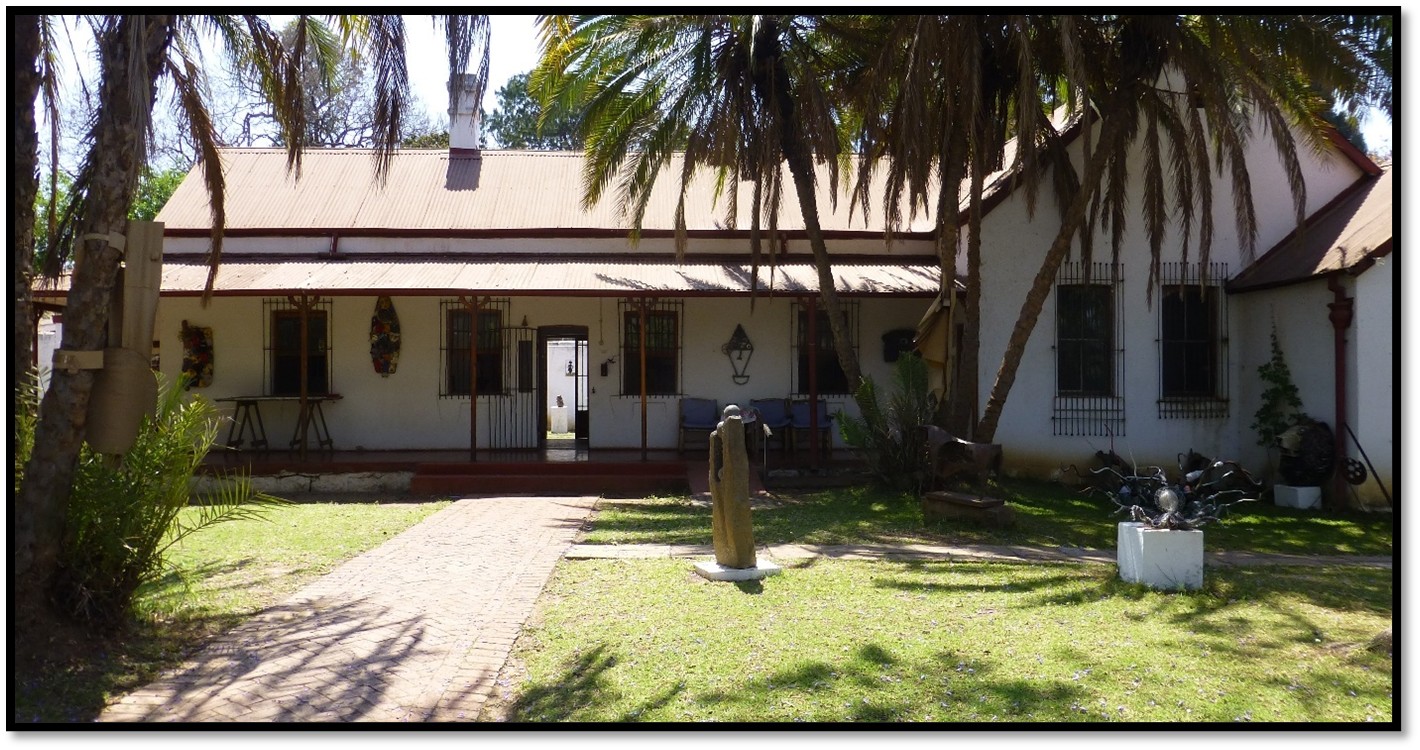
110 Livingstone Avenue, Harare; Gallery Delta in 2016
A history of the House’s owners
Edward Vigne 1894 – 1900: Vigne was born in 1857 at Fort Beaufort in South Africa and practised when he qualifies as a solicitor in Kimberley. He and his brother, Dr Alfred Vigne, came to Mashonaland in 1893 and in August 1893 Edward was admitted to practice in law at Salisbury as the ninth solicitor in the town by Dr Leander Starr Jameson, then the chief Magistrate of Mashonaland.[3]
The building of Harare’s earliest surviving house[4] by Vigne began in 1894 when he was working in the legal practice of Malley and Honey, the beginning of Honey and Blackenberg, who still practice today as the oldest legal firm in Zimbabwe. However Vigne suffered from depression; in late November 1908 he disappeared from the Mazoe (now Mazowe) Hotel and his body was found in the bush on 9 December. He had sold the stand with the house in 1900 for £700.
A keen cricketer he funded the Vigne Cup; still a cricket tournament that is organized by the Harare Metropolitan Cricket Association (HMCA) to the present.
Next owner 1900 – 1901: Vigne sold the house in 1900 which then was made up of two narrow thatched rooms, with a separate iron-roofed kitchen and bathroom. This owner sold the house in 1901 for £400 to Leonard Wigg.
Leonard Wigg 1901 – 1902: Wigg had plans drawn up that connected all the rooms under a corrugated-iron roof making it into the present-day external structure except for the additional front gable added by the Paul’s in 1940.
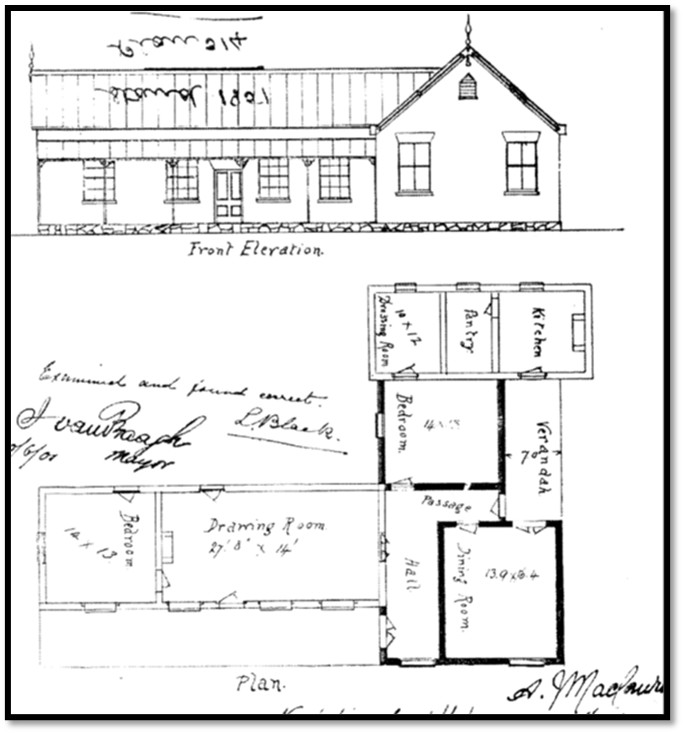
1901 Extension Plans (via Restorica)
In 1902, soon after completion the house was sold again to James Ffolliott Darling.
James Johnston Ffolliott Darling 1902 – 1907: Darling bought the renovated house for £1,500. He was born in 1859, failed his final exams to qualify as a doctor at Trinity College, Dublin and emigrated to the Cape in 1883, where he worked as a medical orderly with the Cape Mounted Rifles (CMR) He was appointed to A Troop of the 1890 Pioneer Column, but transferred to B Troop. He was granted Darlington Farm, now a suburb of Mutare, before starting prospecting. He was working near the Alice Mine, Mazoe in June 1896 and served in a distinguished way with the second Mazoe Patrol and then as a lieutenant with the Salisbury Field Force and with the Rhodesia Horse in the Anglo-Boer War[5]
He invested successfully in property in Salisbury. Leaving the country in 1909 he lived as a gentleman-farmer in Ireland.
Various owners 1907 – 1911: The house was owned through a number of companies in this period, several of which went into liquidation.
Transvaal and Rhodesia Estates 1912 – 1922: It is not known if the house was used in a residential capacity during this period, or as a company office.
Ethel Cooper 1923 – 1928: Presumably, Miss Cooper, a spinster, used the house as her home
Marie Hawkins 1928 – 1933: The new owner added a separate garage in 1929 and an additional verandah, now enclosed, was added to the east side of the house in 1933
Dreen Hawkins 1933 – 1936: the daughter of the above Marie Hawkins and a well-known tennis player who moved into the house in 1933. The following year the original earth closets were replaced and connected to the new municipal sewer in the lane behind. Mrs Hawkins sold the house to her daughter and Robert Paul in 1953.
Dreen Hawkins marries Robert Fowler Paul 1937 – 1980: After their marriage in 1937 a further bedroom and bathroom were built onto the house with an additional gable to the front elevation.
Robert Fowler Paul (1906 – 1980)
Peter Jackson writes that for forty years this was the home of Robert Paul whom he considers was Rhodesia’s (present-day Zimbabwe) most eminent landscape painter.
He went to school at Monkton Combe near Bath and on leaving took up a series of dreary clerical jobs in London. Mercifully for his sanity, he did not stick them for long and joined the British South Africa Police, in 1927, only retiring in 1951 to paint full-time. His talents were recognised in the Police, he was employed as a cartographer to sketch from horseback, and he spent some years roaming and charting the Save Valley and other remote corners of the country.[6] During his patrols by horseback around the farms and Tribal Trust lands (Communal lands) came to love the landscape of trees and kopjes. He was self-taught as an artist and usually took his sketchbook along to record whatever landscapes pleased him. John Piper, the well-known UK artist who became a life-long friend encouraged him with his modern art and who was a major influence and introduced Paul to the technique of gum resist which became a significant part of his painting method. In 1948 he spent several months with John Piper and Piper’s enthusiasm for his recent discovery of the bleak and uninhabited landscape of Wales was probably a big influence on Robert Paul after his return from Britain. He painted scenes whilst on holiday in the Transkei, at Beira, as well as in Salisbury (now Harare) and ever-increasingly in the Inyanga (Nyanga) mountains of Eastern Rhodesia (Zimbabwe)
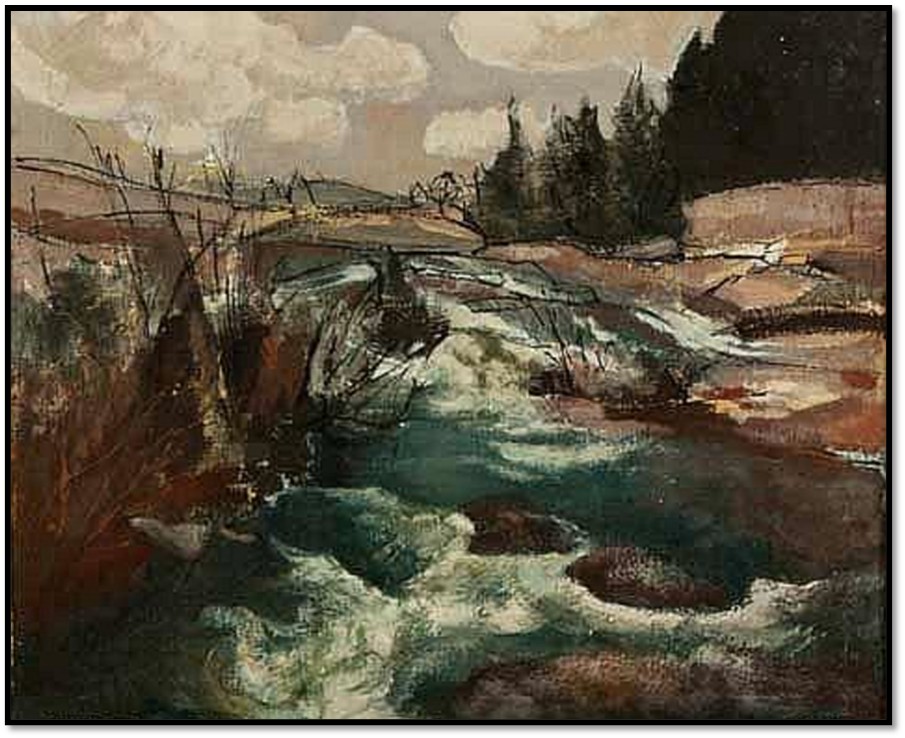
Robert Paul: Nyangombe River
110 Livingston Avenue after 1980
Robert Paul was still living at 110 Livingstone Avenue at the time of his death in September 1980. Dreen died a year later and the property was jointly inherited by their children, Paul and Colette.
The house was rented for the next ten years but by 1991 was in a very bad state of repair. That’s when Colette and Paul approached Derek Huggins with their alternative solution of opening an art gallery. They might have sold the property off as it was zoned for flats and would have released much value to them, but fortunately for the citizens of Harare they did not choose that route.
With Huggins keen on the venue, an application was made in April 1991 to Harare City Council for a change of use with a view to developing an art gallery. This proposal was received with great enthusiasm by the public and aspiring artists alike.
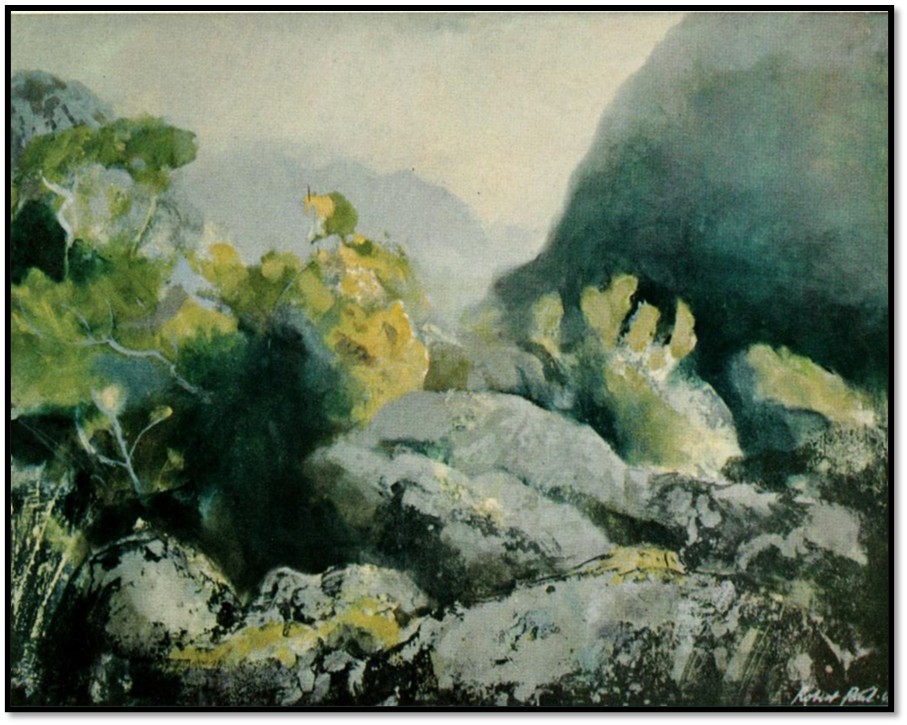
Robert Paul. Summit of Inyangani, 1967, 122 x 91co, oil/tempera on hardboard
His daughter, Colette Wiles wrote, “Holidays were a great treat. Early holidays were spent in Beira. In those days we went by train and Rhodesia Railways moved mighty slowly! When it reached Macheke, the train stopped and everyone got out, including the driver, and headed straight into the nearby hotel pub. Travelling by train was a hot, thirsty business. Robert was very interested in the Portuguese architecture in Beira and sketched the houses with their balustraded gardens along the roads. He loved Nyanga and spent many holidays there with the family, and also with Paul just fishing and painting. The kaleidoscopic colours of Nyanga fascinated him and he particularly loved the deep rust colours of some of the dirt roads there. Because he was away from the stresses of work, his moods on holiday were generally tranquil, and he was able to paint and sketch to his heart’s content. But he was unpredictable. Sometimes on returning home to 110, he would be depressed and moody and not paint again for days.”[7]
Pip Curling describes the structure and romanticism in Paul’s paintings, “Paul’s interpretation of the African landscape suggests a dislocation between his love of its space and grandeur and an inner feeling of alienation in a hostile environment. Many of his mature landscape paintings in Zimbabwe were of the underpopulated areas of the Nyanga mountains or the bleak, baobab-inhabited planes of the lowveld. His deliberate avoidance of the human element in these paintings could, on one level, be that of the archetypal European coloniser who ignores the existence of the indigenous people but could equally be expressive of the soul of an Englishman coming into contact with the spiritual munificence of a land unsullied by industrial excrescence and waste. The former theory might be more politically fashionable in the present day but the latter is more likely to be the truth.”[8]
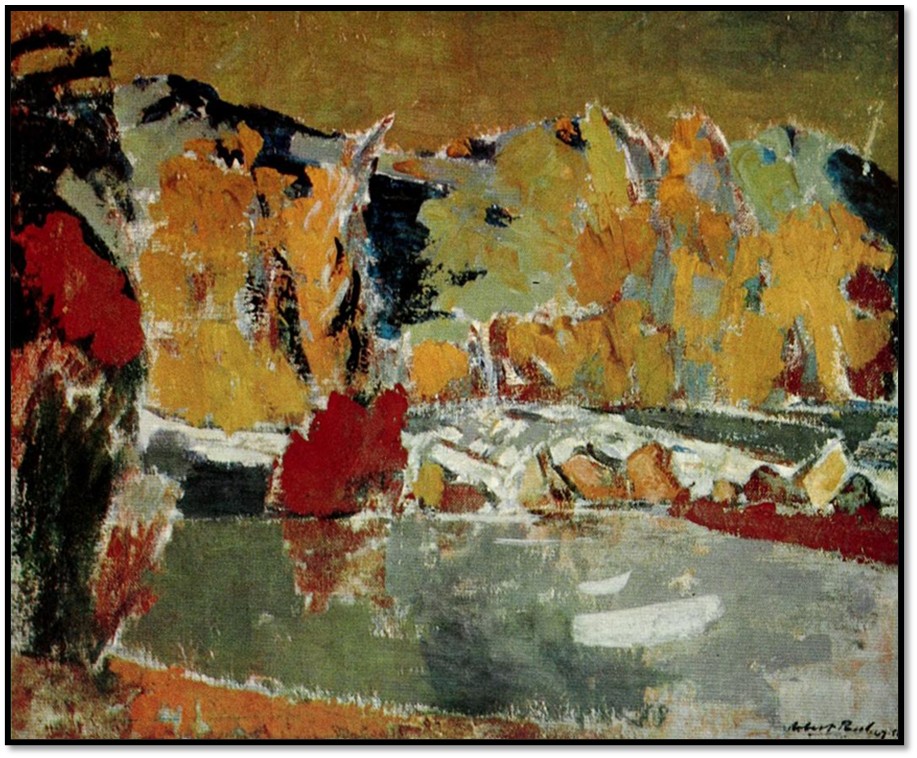
Robert Paul, The Pool, 1976, oil on canvas
Peter Jackson writes, “His paintings however did not only depict landscapes, either real or abstract; Paul also liked to paint buildings, and he clearly appreciated the special qualities of many older structures.”[9]
In 1976 the National Gallery of Rhodesia displayed a retrospective exhibition of over 250 of his paintings and actually purchased about thirty of them. Both Frank McEwen, the Director of the National gallery and his successor, Brian Bradshaw, thought Robert Paul was one of the finest artists in Africa. In 1980, the year he died, the National Gallery of South Africa gave him an exhibition in Pretoria, the first time a Zimbabwean artist was so honoured.[10] The September 1994, edition of Gallery, the art magazine from Gallery Delta, was dedicated to the house at 110 Livingstone Avenue, Robert Paul and Gallery Delta.
Derek Huggins describes the development of Gallery Delta at Robert Paul’s House
In January 1991 Huggins was told they would have to vacate Strachan’s Buildings. In May Colette and Paul, Robert Paul’s children, offered 110 Livingstone Avenue as a gallery space. He realised it would make a good gallery - it is an L shape, with length and interesting areas, but a big restoration and conservation would be required. There was the historical aspect also as one of the few surviving unaltered early settlers’ homes and with the art connection to Robert Paul.
Work began in June 1991. The garden, about half an acre, was a jungle that took three weeks to clear. In early August renovations on the house began. The walls needed replastering, doorways had to be blocked up and opened, wooden window frames and floor boards repaired and replaced, ceiling beams restored. As always, the restoration was bigger than anticipated, but with a good building crew behind the work, on 3 December an exhibition was opened with paintings and drawings by Robert Paul. Everyone at the opening ceremony acclaimed the gallery as a great success with a good and gentle feel about the spaces.
In January, the repair and restoration operation moved to the very back of the stand; repairing walls, toilets, kia. In February, the crew moved into the very derelict old (1894) kitchen area with sun-dried brick of that time and dhaka walls which from rotten gutters and heavy rain had turned to mud.
In March building started on the rear of the building that was almost derelict, disused and badly vandalised by squatters who came over the rear wall of the property. The building crew made daily progress; money came in with donations of bricks, guttering and timber. By now, five exhibitions have been held in the gallery.
In March, the wall of the old kitchen was pulled down and what a difference it made. Light from the winter sunshine coming from the north now poured through the French window into the main gallery and the old drawing room and there was a much better view of the rear courtyard. A small area of the rear verandah was enclosed and what had passed as a bathroom now became a new kitchen. It was planned the rear courtyard would become a display space for sculpture with an open rear verandah.
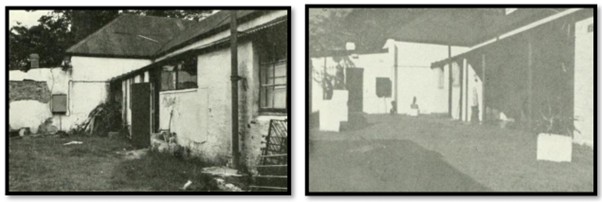
By early August, the major structural work was complete and the fascia boards, guttering and internal painting was being done. One-third of the space needed to be renovated still for exhibition purposes. But art exhibitions were being held to bring in the cashflow. In the end the plan was to save the oldest house in Harare oldest house in Harare which has a historical, architectural and artistic background to be used as an art and cultural centre.
In September, the blocking wall in the hall is taken down to create a large renovated gallery space that Helen Lieros calls the ‘Cathedral Room’ that is set off by two magnificent tall double doors and high ceiling and has a wonderful calm feeling within.
By December, the guttering is on, the corrugated iron roof sheets secured and they are pressing on with the building the amphitheatre and digging and lining the well before the onset of the rains. Peter Jackson formally opened the house at 110 Livingstone Avenue, Harare as Gallery Delta in December 1991
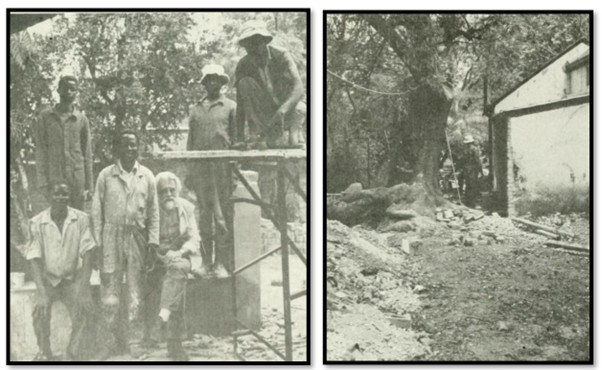
The building team The side of the house before construction
In January and February 1992 work commences on the amphitheatre on the east side of the house with the first staged presentation on the 21 February. In March the front verandah floor is replaced, and in June, Derek moves into his little office at the back that used to be the kitchen. By August all those finishing jobs are completed and the Delta Gallery is finally ready.
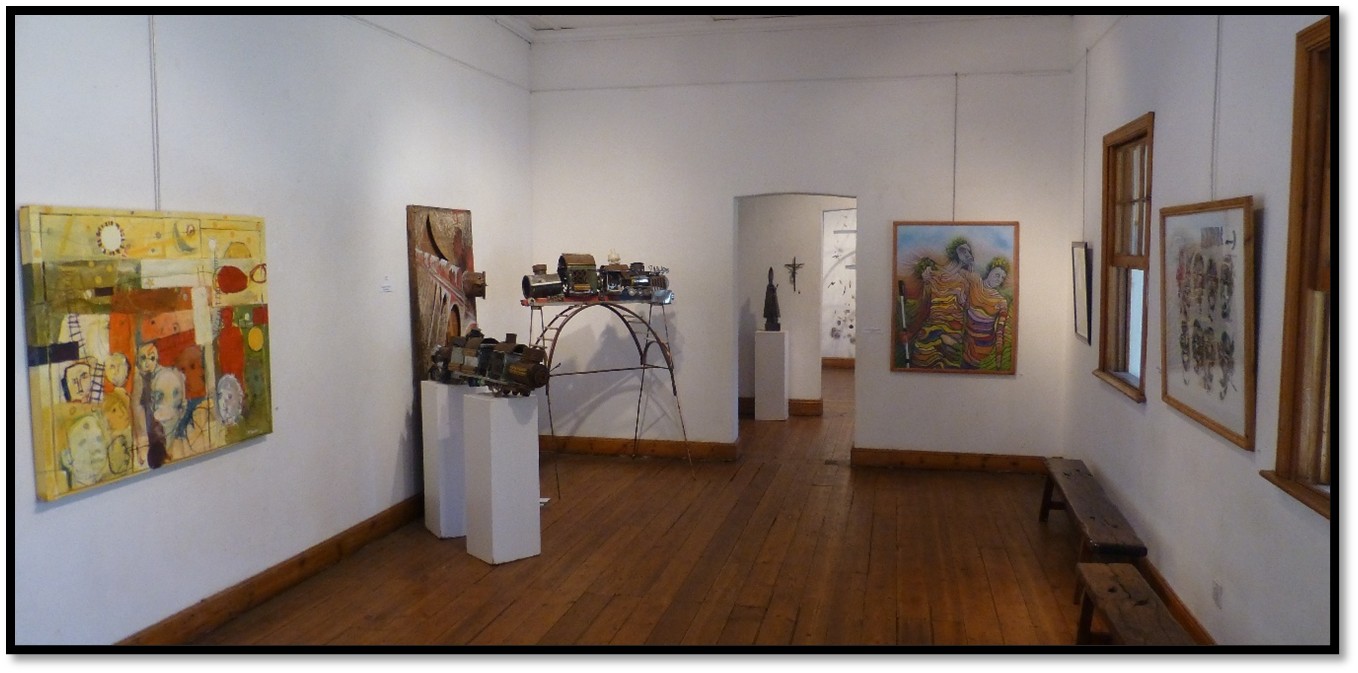
Gallery Delta: interior photo of the main gallery space
The house described by Colette Wiles, daughter of Robert Paul
“Perhaps 110 was originally like so many other Avenue houses - strictly functional, rather dark and slightly depressing. However, it was unlike any of the other houses in that it was large and long, and the garden was generous in size. Until the late 1940’s there were always tenants occupying various parts of the house and at one stage the big living room was halved by a thick enormous curtain to create more rooms for tenants. Dreen never had any domestic help. When we lived in the east wing, she would have to chop wood to feed the old boiler for hot water to do the washing in the old cast iron bath with claw feet now standing in the back courtyard of Gallery Delta. The old coal stove was used to heat heavy metal irons for all the ironing.
The family was able to spread out once we occupied the whole house (apart from the cottage), but Dreen’s workload doubled; the house was impossible to keep clean. Everything in it was second or third hand. All the floor boards were warped, which meant that the carpets were cleaner, but barer, over the upward curving edges of the boards and since sweeping seemed to produce more rather than less dust, this was kept to a minimum! Dreen did all the washing up outside on a concrete surface which she built herself adjacent to a low garden wall made entirely of gin, brandy and vodka bottles! Observing this, a friend of the family once commented that the kitchen garden was pure Tennessee Williams! Dreen was adept at ad hoc improvements, removing iron roof sheets to let more light into the living room and getting water to the kitchen by a hose pipe fed through the window from the bathroom boiler. Robert insisted on three cooked meals a day which she always provided. And then there were many hours spent working in the garden. One day Dreen and I decided to build a small pool, which is still there, to cool off after the heavy digging sessions. Yet, she still had plenty of energy for tennis and was always ready to join in any parties.”[11]
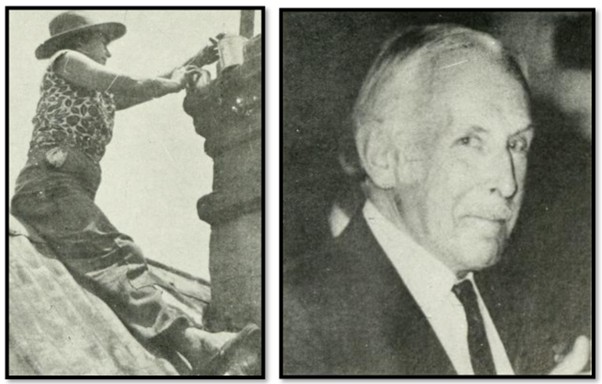
Dreen fixing the chimney at 110 Livingstone Avenue Robert Paul at a party c. 1977
Extracts from Colette Wiles[12] article on her father Robert Paul at work
“Among my strongest memories of life at 110 is the memory of Robert painting in the early morning light near the corner of the verandah next to his bedroom and studio at the west end of the house. There he would be in his paint-spattered dressing gown, brush in hand, bent slightly over the rickety old deal table which leant against the wall, a study in concentration as he took a step back to view the results, his distinguished greying head tilted slightly in critical appraisal. The morning sun threw good light on his work, and on the dust and rubbish that accumulated everywhere - the spatters of oil paint on the table, empty turps bottles, abandoned canvases, egg shells (broken in making the egg tempera he used), cigarette stubs, the browning edges of abandoned water colours, many of them half-finished, some barely begun, forming a pile beneath the one he was working on. Robert's old wooden easel used to be propped against one of the brick pillars and at one time was the favoured perch of a Lizard Buzzard…
…Roberts’ mood when painting was positive, forward-looking, challenged; a great contrast to the intervening despondency when he would not touch a drawing or painting for weeks, declaring that he could not stand painting anyway; that for him it was a compulsion…
…After breakfast at the circular oak table which was the focus of family life and which was set in front of the fireplace between the front door and the kitchen door, Robert would sit in his comfortable brown armchair opposite the propped-up painting He would study the work with a benign, almost content expression for a long time, then pick it up, take it back to the table on the verandah and continue working on it for three or more hours, still clad in his dressing gown. Sometimes at a loss as to how to proceed, he would ask Dreen for her opinion, "...perhaps a bit of cloud there to fill the space." He would alter it as suggested, and then invariably say, "Now you've made me stuff it up!" At 10.30 am Robert would swear that he could hear the pub doors opening, stop working, get dressed and drive up to one of the clubs to meet friends in the bar where he would stay till lunchtime. Sometimes when work was progressing well, he didn't go to the pub, but went back to his chair, seated with his arms on the wooden armrests, a gin and tonic in his right hand, scarcely taking his eyes away from the painting balanced against the sofa in front of him….
…When his painting moods were with him, the house was more or less taken over: the air was redolent with the foul smell of size being boiled up over a little hot-plate in the kitchen, the bathroom would have oil paint everywhere, brushes being cleaned in the bath, and often the bath itself filled with paintings undergoing the water treatment (removal of the unwanted areas of a painting by the process of gum-resist). Another smell which pervaded the house was linseed oil, added with turps as part of the medium to the oil paint. The raw linseed oil had to be purified and Robert used to do this by pouring the oil onto a saucer and placing it somewhat precariously atop the corrugated iron sheets forming the kitchen roof (now the back verandah) to bleach in the sun…
…The room which was actually the 'studio' was a small enclosed area of the verandah, but it very quickly filled up with rolls of paper, paintings and artists materials As Robert painted, so he retreated out of the room itself and onto the verandah, and when that became full, his bedroom was next! There were paintings and drawings everywhere, piled against bedroom walls, under Robert's bed, even his bedroom was seldom cleaned He refused to put anything away, and Dreen refused to sweep and dust until he had done so, so month after month saw increasing levels of dust, with papers, odd sketches, paintings, bits of charcoal, correspondence, bar receipts, empty cigarette cartons and general detritus.
When I could stand it no longer, I would announce my intention of cleaning out my father's bedroom, he would complain bitterly at first, however, once into the spirit of it, Robert would join in the tidying session, throwing away with great gusto those sketches, drawings and paintings which he considered to be no good (most of them); piling them high into the dustbin situated in the sanitary lane at the back of the house. I can remember then visiting the dustbin with my mother, giggling together as we retrieved some of the paintings and sketches with comments of "you never know, Robert may one day become famous. Let's save these just in case." And the rescued work would be stashed away in the loft near the east bathroom; again, gathering dust until some of them were dug out for the retrospective Exhibition in 1976. Robert's bedroom was probably the room of greatest character in the house. It is now a respectable office / gallery but was remembered vividly by all who passed through it - the shambles of dust, unmade bed, paintings and generally dishevelled appearance- a complete contrast to Robert himself, who always looked immaculate even when he had slept in his suit, which he did regularly! When I had left home, married and was working in England my mother sent wonderfully descriptive and hilarious letters of events at 110. One letter described a particularly heavy session at the Sports Club the night before. Mum wrote "Robert woke up this morning not only with a strange woman in his bed, but a strange dog, too!”
Salisbury’s (present-day Harare) oldest buildings
The only older surviving buildings in Harare[13] are the 1892 Government Offices “The Stables” in Samora Machel Avenue and the 1893 Market Hall.
The Stables (1892)
E.E. Burke writes that “for many years, indeed for as long as memories go, the jumble of Government buildings in Salisbury fronting Jameson Avenue, between Third and Fourth Streets, has been colloquially known as "The Stables."[14] The Administration had its first offices here in pole and dhaka huts, and they served from the Occupation in 1890 until the middle of 1892.
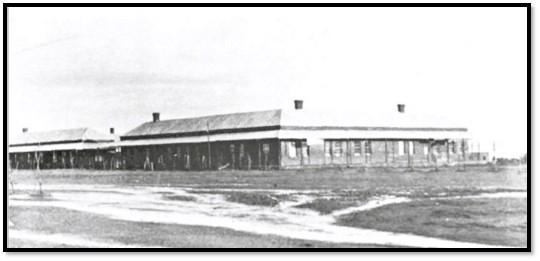
NAZ: “The Stables” in 1898
From 1892 they were the Mining Commissioner's office, Salisbury. The photo below shows the staff in 1907.
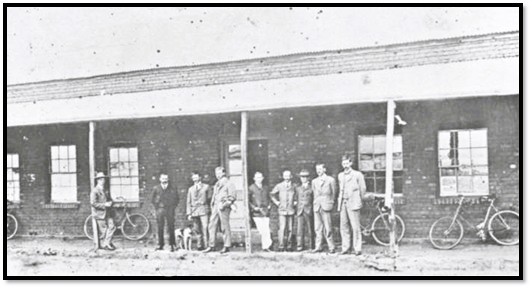
NAZ: Staff of the Mining Commissioner’s office, 1907
During World War II the building was occupied as the headquarters of the Rhodesia Air Training Group (RATG)[15]
The photo below of “The Stables” in 1974 in Jameson Avenue, Salisbury, now Samora Machel Avenue, Harare and at the time of writing the building was occupied by the Department of Works.
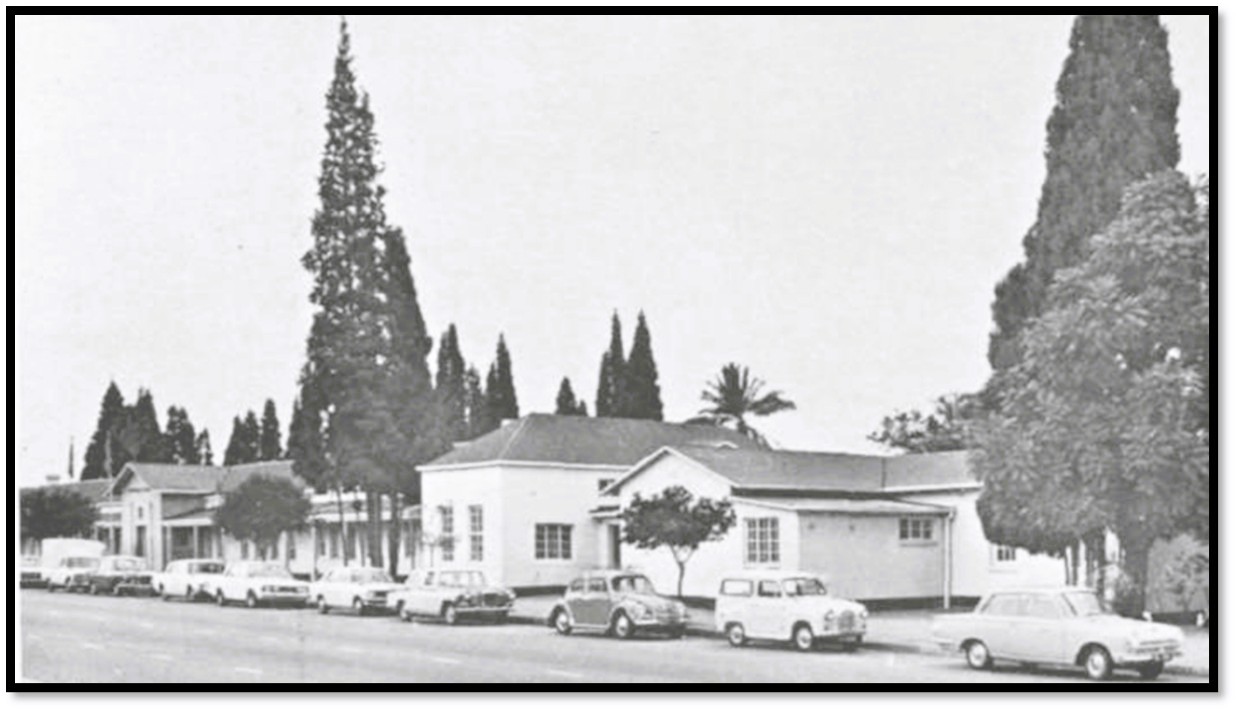
“The Stables” in 1974
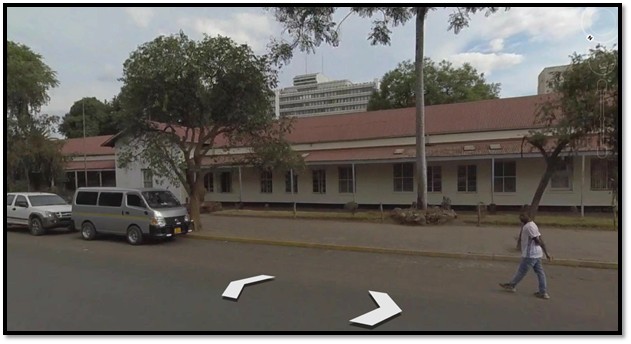
The present-day “The Stables” although much altered over the years
Market Hall
Market Hall faces Market Square, a busy vendors market and bus terminal at the intersection of Mbuya Nehanda Street (formerly Victoria Street) and Bank Street facing Harare’s kopje.[16]
This extract from Rhodesiana No 9, “Mr E.A. Maund, who had recently arrived in town, saw the merit of the undertaking and purchased the Market Building lease from the Company on 31st July 1893. Maund had a pre-pioneer association with the country for in 1885 he had been sent to Lobengula to assure him of the friendship of the British Government and subsequently had sought a concession in opposition to Rudd and his party.
Work was immediately begun on the main hall, which measured 63 feet by 33 feet by 40 feet high. Messrs. Wilson and Richardson were the builders employed. The foundations were put down with true mortar; Mr maund intending his building to be a first-class effort. On Tuesday, 8 August 1893 the foundation stone was laid by Mrs H.J. Deary, wife of a leading merchant.”[17]
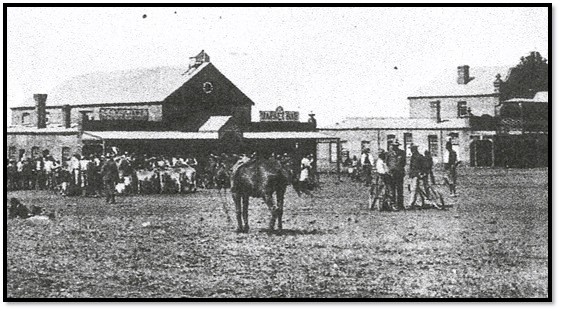
NAZ: Market Hall and Square with an auction in progress

NAZ: A view of Salisbury (present-day Harare) from the Kopje showing the Market Hall, circa 1898
This extract from Edone-Ann Logan’s article in Heritage 26: “The Market Hall, constructed in the infant town of Salisbury in 1893, is a meeting place for town and country folk. Through the years it had housed the Council offices and been leased by various companies as offices. The Hall has been hired out for concerts, roller skating, meetings and cinematograph shows. In 1912 it came under new management and was renamed ‘The Tivoli’. Swing-seats were fitted and the Hall was beautifully decorated and for a year Salisbury residents were treated to a succession of ‘special’ imported films. In 1913 the oldest building in Salisbury reached its lowest point of depression. The Hall became a dumping-place by the Tobacco Company of Rhodesia and South Africa, for unsaleable leaf. In 1949 ownership reverted back to the Municipality. The auction sales on the Market Square however, continued to take place, in spite of the changing activities inside the Hall.”[18]
These buildings were followed in 1895 by “The Residency”[19] and “Mother Patrick's Mortuary.”[20]
References
E.E. Burke. The Rhodesiana Society. Buildings of Historic Interest No 6 “The Stables.” Rhodesiana No 33, 1974, P22-25
Robert Cary. The Pioneer Corps. Galaxie Press 1975
Pip Curling. Space and Place. Gallery, the art magazine from Gallery Delta. Sept 1994, P8-11
R.C. Howland. The Rhodesiana Society. The Market Hall – Salisbury’s oldest building. Rhodesiana No 9, 1963, P37-43
Derek Huggins. Gallery Delta at Robert Paul’s House. Gallery, the art magazine from Gallery Delta. Sept 1994, P13-16
Peter Jackson. Wednesday, 15 Nov 2017. The History and restoration of Harare’s oldest House. Heritage Association of South Africa. Restorica 1994
Edone-Ann Logan. A Forgotten Establishment: the Kopje Institute. Heritage 26 - 2007, P37-41
John McCarthy. The History Society of Zimbabwe. National Museums and Monuments of Zimbabwe: Current Historic Buildings List. Heritage of Zimbabwe No 33, 2014, P65-68
Colin Style. An Englishman Abroad. Gallery, the art magazine from Gallery Delta. Sept 1994, P6-7
Colette Wiles. Robert Paul at 110 Livingstone Avenue. Gallery, the art magazine from Gallery Delta. Sept 1994, P3-5
[1] See the article Edward Carey Tyndale-Biscoe who raised the flag at Salisbury, now Harare on 13 September 1890 under Harare on the website www.zimfieldguide.com
[2] For the controversial question of the selling of land by the British South Africa Company, see the article Land and the British South Africa Company - the Renny-Tailyour and Lippert concessions under Harare on the website www.zimfieldguide.com
[3] Dr L.S. Jameson was chief Magistrate of Mashonaland from 18 September 1891 to 7 October 1893. He was preceded by A.R. Colquhoun and succeeded by A.H.F. Duncan
[4] The only older surviving buildings in Harare are the 1892 Government Offices and the 1893 Market Hall
[5] See the article The June 1896 Mazoe Patrol skirmish with detailed accounts from those besieged and their Mashona attackers under Mashonaland Central Province on the website www.zimfieldguide.com
[6] An Englishman Abroad
[7] Robert Paul at 110 Livingstone Avenue
[8] Space and Place
[9] The History and restoration of Harare’s oldest House.
[10] An Englishman Abroad
[11] Robert Paul at 110 Livingstone Avenue
[12] Ibid
[13] See the article by John McCarthy entitled National Museums and Monuments of Zimbabwe: current Historic Buildings List.
[14] See the article by E.E. Burke entitled Buildings of Historic Interest No 6 “The Stables.” In it he says there is no record of horses being kept here even during the Mashona Rebellion (First Chimurenga) of 1896.
[15] See the article The Rhodesia Air Training Group (RATG) 1940 – 1945 under Harare on the website www.zimfieldguide.com
[16] See the article The Market Hall (1893 – 94) under Harare on the website www.zimfieldguide.com
[17] The Market Hall – Salisbury’s oldest building
[18] A Forgotten Establishment: the Kopje Institute
[19] See the article Harare’s Historic buildings – the Avenues under Harare on the website www.zimfieldguide.com
[20] See the article Mother Patrick’s Mortuary (1895) under Harare on the website www.zimfieldguide.com
